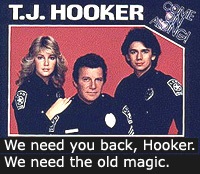
While I was washing my car today, AC/DC came on the radio. This was the Bon Scott-era AC/DC, not the Brian Johnson version, which I consider to be superior. Anyway, it occurred to me that Bon Scott is the answer to a burning Rock and Roll Question: “What would it sound like if Bob Dylan fronted a hard-rock band?”
Since most of us are approaching the age where curling up with Trebek is going to be a dominant form of entertainment, this format shouldn’t be too hard to get: 1) Set us up with the answer to the Question, 2) then fill us in on the answer when the suspense is killing us.
Here’s another example:
A: The Goo Goo Dolls.
Q: What would the Replacements sound like if they kinda sucked and got really famous?
And yet another:
A: The Brian Johnson-led AC/DC
Q: What would it sound like if Marge Simpson sang lead in a hard-rock band?
You get the format; this is Rock and Roll Jeopardy. We’ll open the board, but first let’s meet our contestants. First, we have this nerdy guy from Philadelphia who once got stuck in an elevator…




